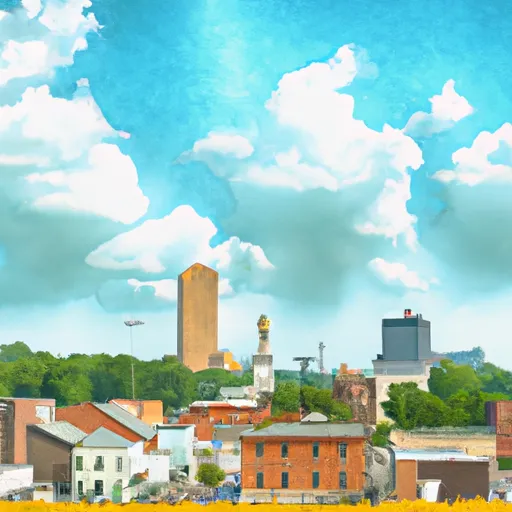-
 Snoflo Premium
Snoflo Premium
Get unlimited access to all our content
With no Ad interruptions! - Start Your Free Trial Login with existing account
Nashville
Eden Index
Climate
8.2
•
Recreation
7.3
•
Community
1.8
•
Safeguard
6.3/10

Nashville, Indiana is a charming town located in Brown County, known for its picturesque landscapes and vibrant arts scene. Nestled in the rolling hills of southern Indiana, Nashville experiences a humid continental climate, with warm summers and cold winters. The average temperature ranges from around 30°F (-1°C) in winter to 85°F (29°C) in summer, making it perfect for outdoor activities in all seasons.
The town is also surrounded by beautiful natural features and water bodies. The area is dotted with numerous lakes, including Lake Monroe and Yellowwood Lake, offering opportunities for fishing, boating, and swimming. The hydrology constituents in Nashville encompass several creeks and streams, such as Salt Creek and Little Hell Creek, which provide scenic spots for hiking and photography enthusiasts.
Outdoor recreation is a major highlight of Nashville, attracting visitors from across the region. Brown County State Park is a popular destination for nature lovers, offering picturesque hiking and biking trails, camping sites, and horseback riding. The area is also renowned for its vibrant fall foliage, attracting many visitors who come to witness the stunning colors.
Overall, Nashville, Indiana offers a delightful combination of a mild climate, beautiful hydrology constituents, and a plethora of outdoor recreation opportunities, making it a must-visit destination for nature enthusiasts and adventure seekers alike.
What is the Eden Index?
The Snoflo Eden Index serves as a comprehensive rating system for regions, evaluating their desirability through a holistic assessment of climate health, outdoor recreation opportunities, and natural disaster risk, acknowledging the profound impact of these factors on livability and well-being.
Climate Health Indicator (CHI): 8.2
Nashville receives approximately
1176mm of rain per year,
with humidity levels near 81%
and air temperatures averaging around
12°C.
Nashville has a plant hardyness factor of
6, meaning
plants and agriculture in this region thrive during a short period during spring and early summer. Most
plants will die off during the colder winter months.
By considering the ideal temperature range, reliable water supplies, clean air, and stable seasonal rain or snowpacks, the Climate Health Indicator (CHI) underscores the significance of a healthy climate as the foundation for quality living.
A healthy climate is paramount for ensuring a high quality of life and livability in a region, fostering both physical well-being and environmental harmony. This can be characterized by ideal temperatures, reliable access to water supplies, clean air, and consistent seasonal rain or snowpacks.
Weather Forecast
Streamflow Conditions
Patoka-White
Area Rivers
Patoka-White
Snowpack Depths
Patoka-White
Reservoir Storage Capacity
Patoka-White
Groundwater Levels
Recreational Opportunity Index (ROI): 7.3
The Recreational Opportunity Index (ROI) recognizes the value of outdoor recreational options, such as parks, hiking trails, camping sites, and fishing spots, while acknowledging that climate plays a pivotal role in ensuring the comfort and consistency of these experiences.
Access to outdoor recreational opportunities, encompassing activities such as parks, hiking, camping, and fishing, is crucial for overall well-being, and the climate plays a pivotal role in enabling and enhancing these experiences, ensuring that individuals can engage in nature-based activities comfortably and consistently.
Camping Areas
| Campground | Campsites | Reservations | Toilets | Showers | Elevation |
|---|---|---|---|---|---|
| Spring Mill State Park | 220 | 670 ft | |||
| Starve Hollow State Rec Area | 200 | 552 ft | |||
| Brown County State Park | 430 | 899 ft | |||
| Cedars of Lebanon State Park | 117 | 686 ft | |||
| Buffalo Trace Co Park | 64 | 803 ft | |||
| Paynetown State Rec Area - Monroe Lake | 320 | 557 ft | |||
| Yellowwood State Forest | 80 | 613 ft | |||
| Bledsoe Creek State Park | 57 | 609 ft | |||
| Hardin Ridge | 200 | 780 ft | |||
| Delaney Creek Park | None | 584 ft |
Nearby Ski Areas
Catastrophe Safeguard Index (CSI):
The Catastrophe Safeguard Index (CSI) recognizes that natural disaster risk, encompassing floods, fires, hurricanes, and tornadoes, can drastically affect safety and the overall appeal of an area.
The level of natural disaster risk in a region significantly affects safety and the overall livability, with climate change amplifying these risks by potentially increasing the frequency and intensity of events like floods, fires, hurricanes, and tornadoes, thereby posing substantial challenges to community resilience and well-being.
Community Resilience Indicator (CRI): 1.8
The Community Resilience Indicator (CRI) recognizes that education, healthcare, and socioeconomics are crucial to the well-being of a region. The CRI acknowledges the profound impact of these elements on residents' overall quality of life. By evaluating educational resources, healthcare accessibility, and economic inclusivity, the index captures the essential aspects that contribute to a thriving community, fostering resident satisfaction, equity, and social cohesion.

